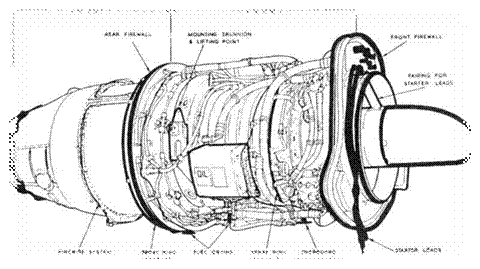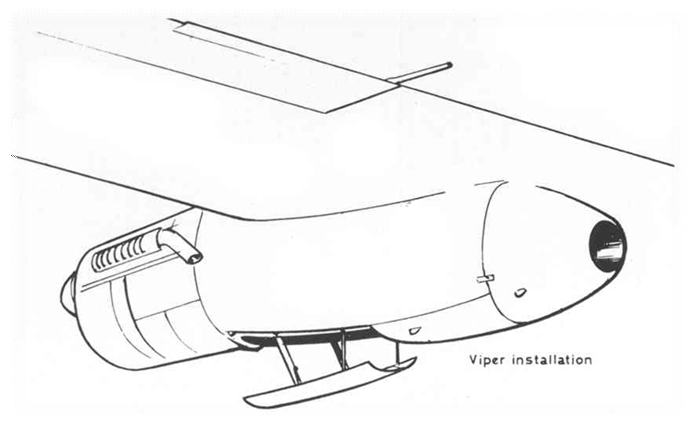THE VIPER

Tom Smith
Tom was the section leader development engineer on this engine project at Coventry
Neil Cairns delightful article "Its Not True Was It" about a Shackleton MkIII flying only on the two Viper engines in the Autumn 1995 Growler inspired me at last to write up the story of the Viper Mk.203 boost engine in the MkIII Ph.3 Shackleton.
Firstly, during the design stage of the project I asked the Avro performance engineer if a lightly laden MkIII could fly on the two Vipers. I was thinking of the classic Shackleton air display sequence of three low passes with one extra Griffon feathered each time, and adding a fourth pass. His answer was YES so Neil's story could just be true, except that of all the things Vipers did and still do, they don't make smoke! That is because of their very efficient annular vaporising combustion chamber (now back in fashion) based on the old paraffin blow lamp.
The original Shackleton requirement was for the Vipers to be used for two minutes only, as takeoff boost to replace the water methanol injection on the Griffons and hence improve their reliability, or so we were told. At about 100 knots the Viper gave roughly the same thrust as a Griffon.
Now to dispel some other myths. The actual Viper 11 (the second generation of Vipers) Mk.203 engine was closer to that still used today in the Jindivik ( now a remote controlled target tug) than the same generation Jet Provost T.Mk.4 & 5 engine. The Shackleton flight development engines were converted from Jindivik Mk.4 Viper Mk.201s. Just to complete the circuit, surplus Jet Provost engines (Mk.202) first built in the early 1960s are about to be converted to Mk.201s, having "worn out" two generations of Jet Provosts. It does rather make the Viper a worthy companion to the Shackleton, particularly as the original Viper 3 first flew from Bitteswell in the tail of a Lancaster in 1952.
The Mk.203 engine was uprated by screwing the wick up - sorry, increasing the fuel flow and thus temperature (which was nothing to do with the change to AVGAS fuel) with a smaller propelling nozzle, to give a 10% increase in thrust to 2,700lbs. The light alloy casings were changed from magnesium alloy to heavier aluminium to stop them fizzing away to nothing with sea water. The throttle and HP cock were controlled by electric actuators, as on the Jindivik, but moving rather faster.
After an exemplary design and development programme in Coventry, the first Shackleton flight with Vipers was made with WR973 on the 29th January 1965 from Langar, Notts. The captain was the EISA Test pilot Dicky Martin and the Bristol Siddeley Flight Test Engineer was Tony Rowley, to whom I am indebted for these flight details. Some 39 flights were made totalling 89 hours, mainly from Woodford. Early flight tests showed that the engine was windmilling backwards and to correct this an air scoop was fitted to the retractable intake door. The engine governor allowed the rpm to creep upwards on a full throttle climb to 1,000ft, which certainly took longer than the two minute Viper rating! The governor was modified to work with a compensating valve (Rate Reset Valve). Another little fault occurred when the air intake door closed on the engine when it was running at idle, if it had been on full throttle it would probably have eaten the door with severe indigestion!
During August WR973 went on to carry out tropical trials at Wheelus U.S. Air Force base in Libya, provoking the usual USAF question on seeing a Shackleton of "what is it?". Aircraft WR980 carried out cold weather trials in Norway with Flt.Lt. Keith Merit in command. Some time later, icing trials on the non antiiced (!) Viper were flown from Boscombe Down with WR989 under Flt.Lt. Bob Beeson. These were carried out behind the water spraying Canberra, which must have been a bit of fun.
In the early 1960s, the Jet Provost Viper 202s had three main problems in service, which are interesting to relate to the Shackleton. The first was vibration, with hindsight due mainly to the engine installation in the aircraft where the crew sat between the air intakes and the seats were effectively bolted to the engine driven gearbox amongst other things. In the Shackleton the Vipers were some yards away from the crew and must have been completely drowned out by those four magnificent 36.7 litre V12 "up and downers". The second problem was oil leaking into the front of the compressor, a menace when using compressor air to pressurise a cockpit but ideal for stopping the engine from corroding in the maritime role of the Shackleton.

The third problem really hit the Shackleton Vipers hard, especially later when they were fitted with an inching button for the throttle to allow the engine to cruise for about 4 hours ( until most of the oil in the small tanks was used up). This problem was hot streaks or pencils of flames from the combustion chamber burning the individual turbine nozzle (or stator) vanes and slotted "tin" carrier rings. The Mk.203 uprating made this even worse and the engine told us about it loud and clear on its Type Test, but the powers that be wouldn't listen to our pleas to fit the new engines with cast segmented nozzles then being offered as a Mod. on the Jet Provost engines "its only got to last two minutes, cannot spend all that money" was the reply. When fitted the Mod. made all the Vipers into an almost unthrashable engine, but the Mk.203 just had to suffer turbine burning.
In service the engine mounted Lucas fuel pump objected to windmilling for long periods due to the inherent lack of lubrication of AVGAS when compared with AVTUR which it was originally designed for. The problem was eventually fixed by taking off that air scoop on the intake door and just letting the Viper rotor rattle around behind the Griffon and hope that the bearings would take it, they did, being a Viper. This is where its pedigree showed up, most components were mansized although it was a small engine. This was because it was really a "miniSapphire", the Armstrong Siddeley Sapphire being used in the Javelin, Victor 1 etc. etc.
Although the Shackleton MkIII service life was relatively short, some say because of the extra weight of the Vipers, it is some comfort to know that at least three aircraft with engines are preserved.
The Viper was developed through two more "generations", the 3,0001bs thrust 301/500 series for the full civil passenger carrying Dominie/HS125 where overhaul lives of 5,500 hours were cleared, and it is also used in the Strikemaster and later Macchi MB326 armed trainers. The current 600 series develops up to 4,400 lbs. thrust with fabulous throttle handling (it stands "hot reslams" in a tailslide!) and powers amongst others, the delightful AerMacchi MB339 used to such good effect by the Italian Air Force in the 'Frecce Tricolori' aerobatic team surely the Red Arrows closest rivals?